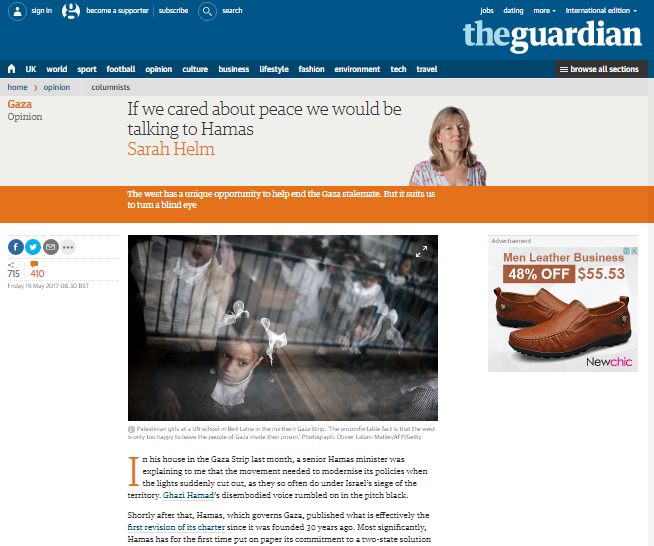This is a guest post by Margie in Tel Aviv.
I do understand Sarah Helm’s desire to paint Hamas in a positive light in her May 19 article at the Guardian. I too wish that their intentions were as positive as she seems determined to present them as being; peace between Israel and the Palestinians – the magical goal that every politician yearns for – would be so much more easily attainable.
Let us look at how she presents their physical situation:
“In his house in the Gaza Strip last month, a senior Hamas minister was explaining to me that the movement needed to modernise its policies when the lights suddenly cut out, as they so often do under Israel’s siege of the territory.”
From this I gather that I am meant to understand that it is Israel’s fault that the lights cut out and that Gaza is under a siege by Israel.
One only has to read the popular press to get the freely available truth. Al Jazeera is hardly unsympathetic to the Palestinian cause:
This headline completely contradicts the impression given by the statement in Helm’s article. The fault is Palestinian alone: the result of a dispute which certainly does not involve Israel.
Al Jazeera continues:
“Abbas has threatened to exert financial pressure on Hamas to cede control of Gaza, a territory it seized in 2007 after a brief war.
Reconciliation attempts since then between rival governments in the Occupied West Bank and Gaza have failed.”
The second fault I find with the sentence from Sarah Helm quoted above is the little matter of a ‘siege’. A siege is understood to be a military assault withholding essential supplies. These usually include food water, medicines and military supplies, in fact everything that can be done to urge the besieged population to surrender speedily and completely.
This is a well trodden path and I can do no better than to quote a passage by Tamar Sternthal of CAMERA establishing that this does not apply.
“As [the NGO] Gisha, hardly a source sympathetic to Israeli policies on Gaza, notes: “Currently, Israel allows the entrance of all civilian goods into the Gaza Strip, with the exception of a list of materials defined as ‘dual-use,’ which, according to Israel, can be used for military purposes.” Gisha’s separate page on dual-use items notes that x-ray machines are in the list of such restricted items, but does not include any other medical equipment.”
Helm herself uses blockade and siege interchangeably, calling Israel’s treatment of Hamas/Gaza both an economic siege and an economic blockade and thereby indicating that she uses those terms without allocating to them due value.
Sarah Helm continues with her dream-vision of a positive Hamas.
“Shortly after that, Hamas, which governs Gaza, published what is effectively the first revision of its charter since it was founded 30 years ago. “
This too is a well trodden – though more recent – path. This public document, as it is known, is far from a new charter. A close reading of the document itself yields no hint that it is intended to be a charter.
In fact, Ms Helm’s claim is contradicted by various Hamas leaders. Here is none other than one of the founders of Hamas, Al-Zahar:
“The pledge Hamas made before God was to liberate all of Palestine,” Zahar said Wednesday. “The charter is the core of [Hamas’] position, and the mechanism of this position is the document.”
Sarah Helm begs the international community to see Hamas more charitably:
“…the movement is at present adhering to a ceasefire, and has gone a long way towards meeting international demands.”
It is hard to see the regular firing of missiles at Israeli civilian communities near Gaza as indication of a ceasefire. The international demands on the Palestinians in general and Hamas in particular have generally been no more demanding than a request for an end to the violence – a consummation devoutly to be wished but as elusive as ever.
Related Articles:




